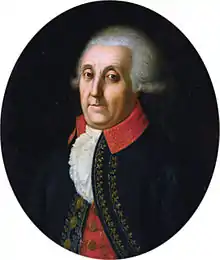Sayn-Wittgenstein-Ludwigsburg
Sayn-Wittgenstein-Berleburg-Ludwigsburg, also known as Sayn-Wittgenstein-Ludwigsburg, was a cadet branch of the Sayn-Wittgenstein-Berleburg family. It was created by Graf Casimir zu Sayn-Wittgenstein-Berleburg (1687–1741, ruled 1694–1741) for his brother, Ludwig Francis (1694–1750). Its seat was Ludwigsburg, a spectacular two-winged manor house in Berleburg built by the master carpenter Mannus Riedesel.
The branch had no territorial holdings of its own and as such had no independent standing in the German Empire. Later generations flourished as officers for the Czar of Russia.[1] With the revolutions and wars of the 20th century, descendants were dispersed throughout Europe and North America.
Counts of Sayn-Wittgenstein-Ludwigsburg
- Ludwig Francis (1694–1750)
- Christian Louis Casimir (1725–1797)
- Ludwig Adolf Peter (1769–1843), raised by King Frederick William III of Prussia to the rank of Fürst in 1834[2]
References
- "GERMAN SCHOOL, 19TH CENTURY". Sothebys.
-
 This article incorporates text from a publication now in the public domain: Chisholm, Hugh, ed. (1911). "Wittgenstein, Ludwig Adolf Peter, Count". Encyclopædia Britannica. 28 (11th ed.). Cambridge University Press.
This article incorporates text from a publication now in the public domain: Chisholm, Hugh, ed. (1911). "Wittgenstein, Ludwig Adolf Peter, Count". Encyclopædia Britannica. 28 (11th ed.). Cambridge University Press.
This article is issued from Wikipedia. The text is licensed under Creative Commons - Attribution - Sharealike. Additional terms may apply for the media files.

